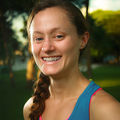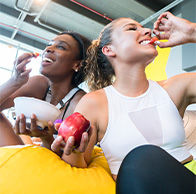The next time you watch a football game, count how many times one of the players does a rolling movement to recover from a tackle. While they make it look easy, the ability to roll is a dynamic whole-body movement that requires upper- and lower-body coordination and postural control (Kobayashi, Watanabe and Taga, 2016).
The muscles that make up the middle and outer layers of the core (including the rectus and transverse abdominis, internal/external obliques, Iliopsoas and erector spinae) are called into play when trying to shift from the back to the stomach in a controlled manner. As a result, rolling exercises are a great way to train the core and assess areas of weakness in the body.
To Roll Effectively, You Must Have:
- Good trunk rotational abilities (i.e., thoracic spine mobility)
- The ability to shift weight between the lower and upper body
- Coordinated abilities to move the head, neck and upper body together
- Mobility of the cervical spine, hips and shoulders
For babies, this is the first milestone in foundational movement. As adults, however, the core musculature required to shift and move the body across all planes of motion becomes weak. Thus, rolling patterns are some of the best core exercises for improving total-body function and decreasing injury risk.
It’s also important to note that rolling patterns are highly dependent on neck movement and eye-tracking to facilitate trunk motions. According to Hoogenboom and colleagues (2009), “neck extension can facilitate extension and abduction of the hip.” In other words, where the eyes, head and neck go, the trunk will follow. Therefore, poor cervical function can impact the entire kinetic chain. Rolling, however, can help improve function throughout the body.
5 Rolling Exercises to Try
The following five rolling exercises are a great way to introduce rolling patterns into a workout. They can be combined into a single circuit workout or can be included individually as part of other circuits.
These exercises require a considerable amount of control and stability, and the muscles often fatigue quickly. When starting out, have clients perform one to three sets of three to six repetitions on each side. Be sure to keep an eye on your client’s technique. As soon as your technique starts to falter, stop the reps and take a break. Remind clients to move slowly and breathe through the movements.
Rolling patterns take practice and should be performed regularly to see improvements. Progression and regressions are available for each exercise using standard principles of lever length, range of motion, external load, and speed/power (slower is better when learning these exercises).
Watch this video for full explanations of technique for each exercise
Starfish Roll
- Set-up position: Begin by lying on back in an X-shape position with arms and legs extended.
- Movement: Cue the client to initiate the movement by lifting the leg off the floor. Keep the rest of the body connected to the floor as the leg crosses over the body. The upper body shouldn’t contribute to the movement; it should simply follow the movement caused by the lower body. The end point of the exercise is lying on the stomach. Return to the starting position by reversing the movement.
- Do the same movement, but initiate from the arm instead of the leg. This requires more coordinated efforts of the neck and thoracic spine to facilitate rolling between supine and prone.
Hollow-plank Roll
- Set-up position: Begin by lying on the back with the arms stretched long overhead and the legs extended. The entire body should be in contact with the floor. Press the hands and the legs together.
- Movement: Initiate the movement by lifting the arms and legs off the floor a few inches—just enough to activate the core musculature. Pull the abdominals in by squeezing the glutes and engage the obliques to lift and roll the body in a controlled manner from supine to prone. Maintain enough control so that the position can be held on the side of the body. Return to the starting position by reversing the movement.
Fetal Roll
- Set-up position: Begin by lying on the back with the legs in table-top position (feet off the floor with knees bent at 90-degrees). Lift the arms and touch the elbows to the thighs; keep the torso relaxed on the floor.
- Movement: Initiate the movement by turning the head toward the direction you want to go. Control the body as it stays in the small position to roll onto the side on the floor. Return to the starting position by first turning the head to look in the opposite direction. Keep the legs bent at 90-degrees, squeeze the glutes, and pull back to supine position without pushing off the floor. It is common for someone to “collapse” when going to the side and to push-off the floor with the arm to return to set-position, but this will improve with practice.
Rolling Like a Ball
- Set-up position: Sit with the knees bent in (heels near glutes) and the hands on top of the shins. Drop the shoulders and round the back to create a C-curve in the spine.
- Movement: Lift the feet off the floor and balance on sitz bones. Initiate the movement by inhaling and pulling the deep abdominals in and up—this should allow the body to roll backward along your spine. Stop the movement at the shoulders (never roll onto the neck). Pause for a moment at the bottom, deeply exhale and use the c-curved position to return to the starting position. The feet can touch the floor or stay lifted for an extra balance challenge.
Backward Roll (advanced)
A backward roll is similar to rolling like a ball except that you fully roll over one shoulder, finishing in a crouched position. It’s important to avoid rolling over the neck and to keep the chin tucked when performing the backward roll. Proficiency in the other four rolls is vital before trying a backward roll.
- Set-up position: Sit with the knees bent in (heels near glutes) and place hands on top of shins. Drop shoulders and round back to make a C-curve in the spine.
- Movement: Lift the legs off the floor and initiate the backward roll with an inhale breath. Keep the chin tucked. Once the roll comes to the shoulder, shift the body to the side and kick the legs through to complete the movement.




 by
by 





 by
by